21.5-inch iMac (Late 2013) Review: Iris Pro Driving an Accurate Display
by Anand Lal Shimpi on October 7, 2013 3:28 AM ESTWiFi & IO
The new iMacs join the 2013 MacBook Airs in supporting 802.11ac. Unlike the MBA implementation however, the iMac features a 3 antenna/3 stream configuration with the potential for even higher performance. Connected to Apple’s new 802.11ac Airport Extreme I was able to negotiate the maximum link rate of 1300Mbps. I will say that maintaining the full speed connection was quite tricky and required very close proximity to the AP, and that the AP was located physically higher than the iMac.

Range was absolutely incredible on the Airport Extreme/2013 iMac combination. I didn’t have time to map out speed vs. distance from AP before leaving on my most recent trip, but I will say that the combination of the two gave me better WiFi range/performance than any other wireless device I’ve ever tested. I need to spend some more time with the two but color me completely impressed at this point.
With OS X 10.8.5 Apple addressed some of the performance issues that plagued real world use of 802.11ac. Prior to the 10.8.5 update,I could get great performance using iPerf, but actually copying files between Macs on the same network never substantially exceeded the performance I could get over 802.11n.
The 10.8.5 update somewhat addressed the problem, raising average performance copying over an AFP share to ~330Mbps. It’s not unusual for software companies to only partially address an issue in existing software, especially if there’s an actual fix coming just around the corner. I had a suspicion that’s what was going on here so I threw OS X 10.9 (Mavericks) on both the iMac and my source machine, a 13-inch MacBook Pro with Retina Display.
The 13-inch rMBP was connected over Thunderbolt/GigE, while the iMac was connected over 802.11ac to the same network. First, let’s look at UDP and TCP performance using iPerf:
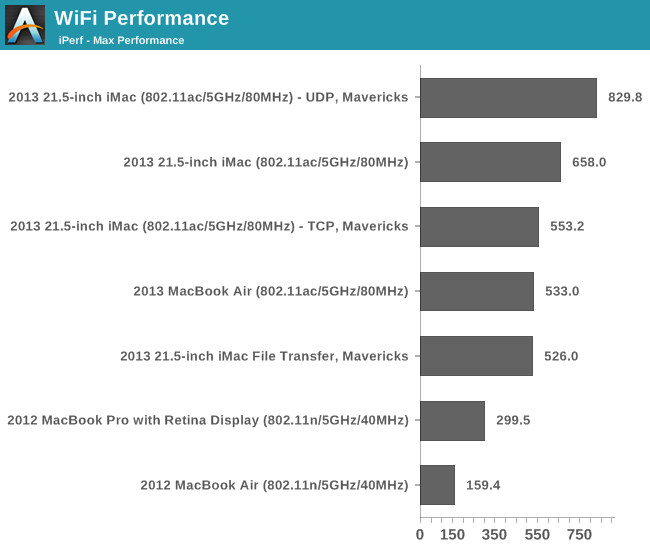
Peak UDP performance is 829.8Mbps. Running the same test using TCP drops performance down to 553Mbps. What about actual file copy performance? I saw peak performance as high as 720Mbps, but average file copy speed over my network setup was ~500Mbps.

You can definitely get better transfer speeds over wired Gigabit Ethernet, but 802.11ac (particularly over short distances) is very good. You’ll need to wait for Mavericks to really enjoy this performance, but the wait is almost over.
The rest of the IO is the same as in last year's model. You get four USB 3.0 ports, two Thunderbolt 1.0 ports, GigE, SD card reader, and a 1/8" jack:
The Chassis
Last year Apple redesigned the iMac, making it thinner at the edges than an iPhone 5/5s or even an iPad mini. Many pointed out that reducing edge thickness didn’t really matter all that much given the center of the iMac bulges out quite a bit. Given that there’s no internal battery you need more space for, reducing chassis volume is purely an exercise in design with no real tradeoffs as long as you can adequately cool what’s inside. I can’t speak to the 21.5-inch iMacs with discrete graphics, but the 65W Haswell + Crystalwell model I was sampled exhibited no thermal issues during even heavy use.
The iMac’s lone internal fan hummed along at ~1400 RPM during light use as well as during repeated Cinebench R15 runs while writing this review. One positive side effect of Intel targeting notebooks for all of its microprocessor architectures is the ease of cooling these 65W “desktop” parts. Keep in mind that Apple delivers a similar amount of performance in a very thin 15-inch notebook chassis as it does in a 21.5-inch iMac chassis.
Despite the reduction in internal volume, the redesigned 27-inch iMac is still a bit bulky to move around. The same can’t be said for the 21.5-inch model however. Weighing only 12 pounds (the equivalent of a small dog or large cat), the 21.5-inch iMac is almost portable. I had to carry it around a lot during the course of my review (between desks, photo area, and in testing WiFi) and I quickly appreciated just how compact this system is. Particularly in its default configuration, there’s only a single cable you have to deal with: the carefully angled power cable going into the machine.
It’s also neat to look at the iMac compared to one of my 24-inch CPU testbed monitors from a few years ago and realize that the two have virtually the same resolution, and the iMac is not only a better display but comes with an integrated Haswell PC as well.


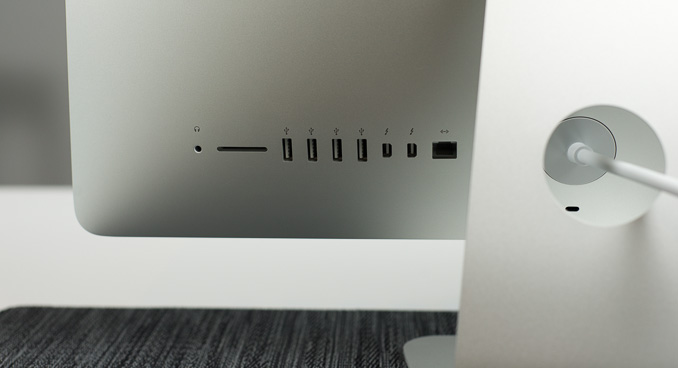
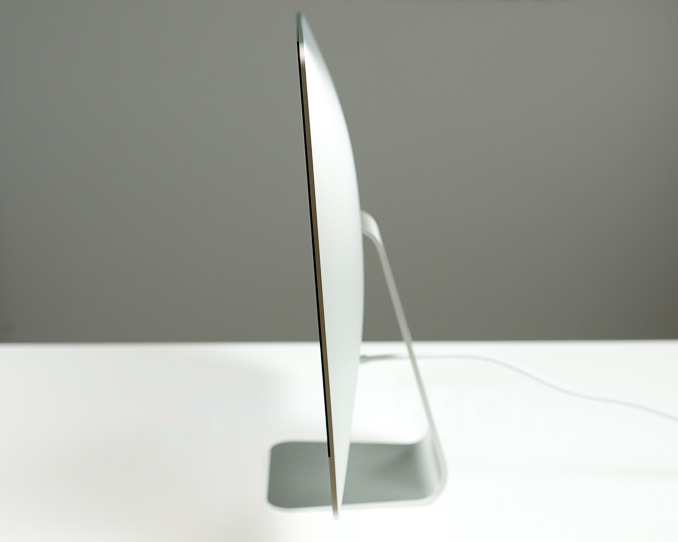
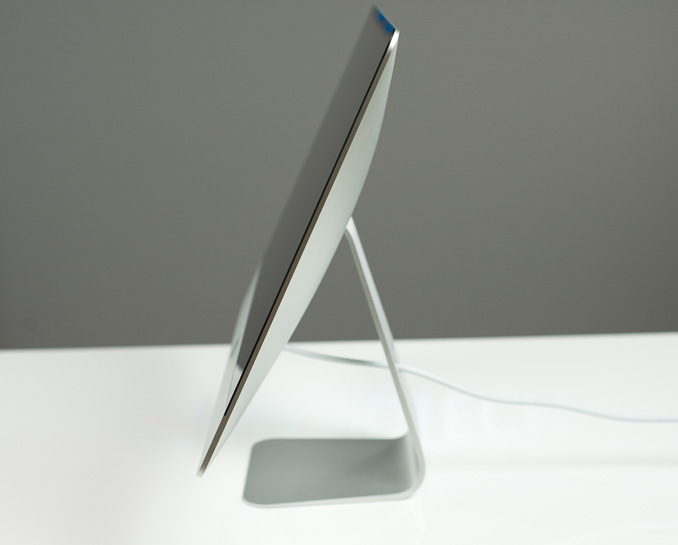
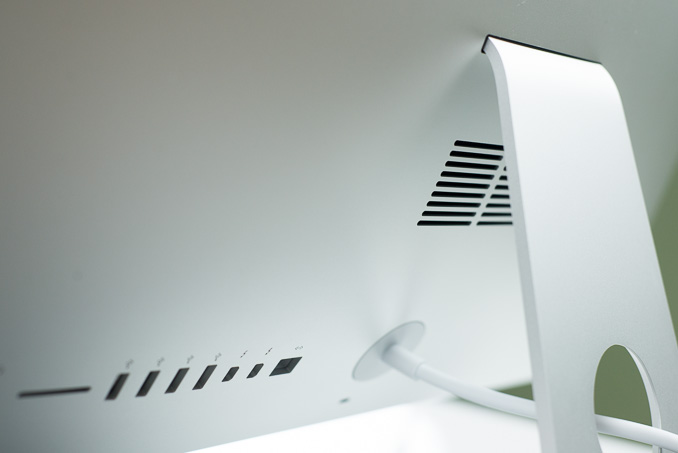








127 Comments
View All Comments
Calista - Tuesday, October 8, 2013 - link
They have become pretty inexpensive nowadays. A Dell 21" Dell Ultrasharp IPS-screen is only 40-50 USD more expensive than the cheapest TN-panel. Still don't think people are fair when complaining about the cost of the iMac. It's quiet, it looks good, it holds a great resale value. A lot of people would think twice about dropping $500 a month of their car, why not spend a few extra quid on a computer? Back in the days a computer was expensive, now it's so cheap it's almost silly.repoman27 - Monday, October 7, 2013 - link
Not that I'd buy a base model 21.5-inch iMac, but I think most consumers could care less about their CPU and GPU specs and are looking more at the overall package. For most office desk jockeys, school computer labs, customer use / internet kiosks, parents, etc., the iMac probably makes more sense than a custom built overclocked gaming rig.It also depends on how much you value what you get in said package. The i5-4570R is essentially an i5-4430S with Iris Pro 5200, so it's likely a $240-270 part. Then there's the rather well calibrated 1920x1080 IPS panel which would run another $150 or so. The keyboard and mouse that are included have a combined retail price of $138. Then there's the 3x3:3 802.11ac Wi-Fi plus Bluetooth 4.0, Broadcom GbE NIC and SDXC UHS-I card reader, Thunderbolt, 720p camera, dual microphones, built-in amp and stereo speakers, plus whatever value you put on OS X and the bundled iLife suite.
Flunk - Monday, October 7, 2013 - link
Screen, form-factor, OS. Performance isn't the number one concern for many people.Dug - Monday, October 7, 2013 - link
Someone that wants everything built in that doesn't sound or look like a piece of crap.Add up everything that is included and it's not that expensive. Especially when you consider the cpu is quad core (almost all laptop i5's are dual core), 802.11ac, dual mics, webcam, speakers, bluetooth, sdxc, thunderbolt, wireless keyboard and trackpad, a calibrated IPS monitor, and the best part is no noise and only one cable with no power brick. Try and do that with any diy build and tell me how much it is.
KoolAidMan1 - Monday, October 7, 2013 - link
IPS screens aren't cheap, nor are AIO designs. Dell, HP, and Lenovo can't get lower prices when they try to compete in specs or display quality either.A $500 laptop isn't going to have a good display, keyboard, or trackpad either, and resale value is going to be nothing. Comparing a trash laptop to something with much higher quality components that holds value over time doesn't make sense.
robsparko - Tuesday, October 8, 2013 - link
This argument is getting old and inaccurate. People don't always want laptops. Additionally, bottom of the barrel hardware has a very short life span. Sometimes, it is nice to have a well integrated AIO without cables running everywhere. Sure, not everyone wants a computer that will last 3+ years and that is perfectly fine.But, just for fun, here's some pricing from NewEgg parts I believe would be of similar quality to an iMac. Yes, you can find cheaper cases/PSU/etc, but an iMac isn't built using the cheapest components. Likewise, feel free to buy a Dell! But, to call people who buy an iMac ignorant/ out of the mind/ etc is just proving a lack of insight into the situation and market pricing.
250 i5 cpu w/ IRIS (good luck finding it! NewEgg's uses HD4600)
150 mobo
75 case
75 psu
235 IPS 21.5" lcd
65 hdd
50 webcam w/ mic
75 ram
140 windows
65 wireless kb/mouse
35 speakers
?? shipping/tax
?? Time to built
----------------
1215 Total + extra
Calista - Tuesday, October 8, 2013 - link
What you did is a game created to let Apple look good. I made a similar list with parts from Newegg. It was only $1150 but included a Shuttle case, a 27" IPS-display from Dell, a 240 GB Intel SSD and 16 GB of RAM. And Windows 8 Retail obviously. A similar config but with a 21" display from Apple was $1870. The 27" iMac with similar configuration was almost $2400, i.e. twice as expensive as the PC.web2dot0 - Saturday, October 12, 2013 - link
Let me guess, your parts are the same part quality as Apple's ? :)The case isn't worth anything, a calibrated monitor isn't worth anything, AIO isn't worth anything, fusion drive isn't worth anything, .... That's cool.
I can play that game too jackass
foolio5 - Monday, October 14, 2013 - link
Are you really equating an inflated price to higher quality parts? Quick tell me the difference between Kingston and Samsung Ram! How do you know his PSU isn't a Seasonic? What exactly is the brand HDD Apple uses? I heard this all the time about quality parts when everything Apple uses is Samsung or Foxconn. Yes Foxconn... the epitome of quality OEMs!You are adding a lot of money for having an AIO. He is using a Dell 27" IPS, that should clue you into the fact that it is an Ultrasharp which is calibrated, also hes using an SSD so again tell me how a Hybrid beats out an SSD.
Lastly, are you 12 or something. Your name calling is immature.
abazigal - Tuesday, October 8, 2013 - link
I would (if I didn't already own a 2011 27" imac), which I found to be worth every cent.It makes perfect financial sense when you realise that you are not so much buying a computer, as you are getting an integrated solution that's ready to use right out of the box. I find that Macs come with excellent functionality without me having to spend much time setting it up.
Already, it comes preloaded with the excellent iLife suite, a great pdf annotation reader (preview), a stable OS that continues to run smoothly 2 years on without me needing to do anything to maintain it, entry to the Apple ecosystem, and access to fairly inexpensive Mac software.
Then, there is the good aftercare service. Once, my Imac developed screen issues. I made a call to the service centre. 20 minutes later, an appointment was made. They came down to my house the next day, brought it back for servicing, and delivered it back to my house 2 days later. Problem solved with minimal effort or stress on my part.
So in the end, the extra that I am paying is well worth it for the promise of a seamless and hassle-free computing experience. Which I value more than if I were to simply build a desktop using parts sourced individually (and then having to deal with all the troubleshooting on my own subsequently).